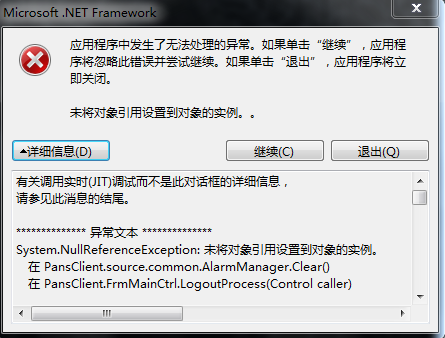如何让C#程序崩溃时不弹出.net错误?
我的想法是崩溃时,仅仅友好的告诉客户:程序崩溃了。
错误信息打算写log,有人有过这样的例子吗?
[解决办法]
try
{
}
catch(Exception e)
{
//记录错误信息
}
[解决办法]
Main入口。
/// <summary>
/// 应用程序的主入口点。
/// </summary>
[STAThread]
static void Main(string[] path)
{
Program prog = new Program();
try
{
Application.EnableVisualStyles();
Application.SetCompatibleTextRenderingDefault(false);
Application.ThreadException += (System.Threading.ThreadExceptionEventHandler)delegate(object sender, System.Threading.ThreadExceptionEventArgs e)
{
//这里处理线程异常
};
AppDomain.CurrentDomain.UnhandledException += (UnhandledExceptionEventHandler)delegate(object sender, UnhandledExceptionEventArgs e)
{
//这里处理其他未捕获的异常信息
};
Application.Run(new MainForm);
}
catch (Exception ex)
{
//这里处理标准异常
MessageBox.Show("程序出错:" + ex.Message);
Application.Exit();
}
}
// Starts the application.
[SecurityPermission(SecurityAction.Demand, Flags = SecurityPermissionFlag.ControlAppDomain)]
public static void Main(string[] args)
{
// Add the event handler for handling UI thread exceptions to the event.
Application.ThreadException += new ThreadExceptionEventHandler(ErrorHandlerForm.Form1_UIThreadException);
// Set the unhandled exception mode to force all Windows Forms errors to go through
// our handler.
Application.SetUnhandledExceptionMode(UnhandledExceptionMode.CatchException);
// Add the event handler for handling non-UI thread exceptions to the event.
AppDomain.CurrentDomain.UnhandledException +=
new UnhandledExceptionEventHandler(CurrentDomain_UnhandledException);
// Runs the application.
Application.Run(new ErrorHandlerForm());
}
// Programs the button to throw an exception when clicked.
private void button1_Click(object sender, System.EventArgs e)
{
throw new ArgumentException("The parameter was invalid");
}
// Start a new thread, separate from Windows Forms, that will throw an exception.
private void button2_Click(object sender, System.EventArgs e)
{
ThreadStart newThreadStart = new ThreadStart(newThread_Execute);
newThread = new Thread(newThreadStart);
newThread.Start();
}
// The thread we start up to demonstrate non-UI exception handling.
void newThread_Execute()
{
throw new Exception("The method or operation is not implemented.");
}
// Handle the UI exceptions by showing a dialog box, and asking the user whether
// or not they wish to abort execution.
private static void Form1_UIThreadException(object sender, ThreadExceptionEventArgs t)
{
DialogResult result = DialogResult.Cancel;
try
{
result = ShowThreadExceptionDialog("Windows Forms Error", t.Exception);
}
catch
{
try
{
MessageBox.Show("Fatal Windows Forms Error",
"Fatal Windows Forms Error", MessageBoxButtons.AbortRetryIgnore, MessageBoxIcon.Stop);
}
finally
{
Application.Exit();
}
}
// Exits the program when the user clicks Abort.
if (result == DialogResult.Abort)
Application.Exit();
}
// Handle the UI exceptions by showing a dialog box, and asking the user whether
// or not they wish to abort execution.
// NOTE: This exception cannot be kept from terminating the application - it can only
// log the event, and inform the user about it.
private static void CurrentDomain_UnhandledException(object sender, UnhandledExceptionEventArgs e)
{
try
{
Exception ex = (Exception)e.ExceptionObject;
string errorMsg = "An application error occurred. Please contact the adminstrator " +
"with the following information:\n\n";
// Since we can't prevent the app from terminating, log this to the event log.
if (!EventLog.SourceExists("ThreadException"))
{
EventLog.CreateEventSource("ThreadException", "Application");
}
// Create an EventLog instance and assign its source.
EventLog myLog = new EventLog();
myLog.Source = "ThreadException";
myLog.WriteEntry(errorMsg + ex.Message + "\n\nStack Trace:\n" + ex.StackTrace);
}
catch (Exception exc)
{
try
{
MessageBox.Show("Fatal Non-UI Error",
"Fatal Non-UI Error. Could not write the error to the event log. Reason: "
+ exc.Message, MessageBoxButtons.OK, MessageBoxIcon.Stop);
}
finally
{
Application.Exit();
}
}
}
// Creates the error message and displays it.
private static DialogResult ShowThreadExceptionDialog(string title, Exception e)
{
string errorMsg = "An application error occurred. Please contact the adminstrator " +
"with the following information:\n\n";
errorMsg = errorMsg + e.Message + "\n\nStack Trace:\n" + e.StackTrace;
return MessageBox.Show(errorMsg, title, MessageBoxButtons.AbortRetryIgnore,
MessageBoxIcon.Stop);
}